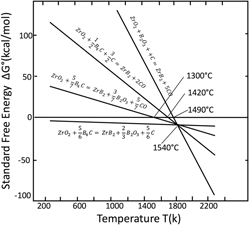Crossref Citations
This article has been cited by the following publications. This list is generated based on data provided by
Crossref.
Gild, Joshua
Zhang, Yuanyao
Harrington, Tyler
Jiang, Sicong
Hu, Tao
Quinn, Matthew C.
Mellor, William M.
Zhou, Naixie
Vecchio, Kenneth
and
Luo, Jian
2016.
High-Entropy Metal Diborides: A New Class of High-Entropy Materials and a New Type of Ultrahigh Temperature Ceramics.
Scientific Reports,
Vol. 6,
Issue. 1,
Henschel, Anne
Binnewies, Michael
Schmidt, Marcus
Borrmann, Horst
and
Grin, Yuri
2017.
Crucible‐Free Preparation of Transition‐Metal Borides: HfB2.
Chemistry – A European Journal,
Vol. 23,
Issue. 63,
p.
15869.
Fahrenholtz, William G.
and
Hilmas, Greg E.
2017.
Ultra-high temperature ceramics: Materials for extreme environments.
Scripta Materialia,
Vol. 129,
Issue. ,
p.
94.
Li, Fei
Huang, Xiao
and
Zhang, Guo‐Jun
2017.
Recent Applications in Sol-Gel Synthesis.
Zou, Ji
Rubio, Virtudes
and
Binner, Jon
2017.
Thermoablative resistance of ZrB2-SiC-WC ceramics at 2400 °C.
Acta Materialia,
Vol. 133,
Issue. ,
p.
293.
Cao, Weixiao
Wei, Ya'nan
Meng, Xin
Ji, Yuexia
and
Ran, Songlin
2017.
A general method towards transition metal monoboride nanopowders.
International Journal of Materials Research,
Vol. 108,
Issue. 4,
p.
335.
Gupta, Aayush
Singhal, Varun
and
Pandey, O.P.
2018.
Facile in-situ synthesis of NbB 2 nanoparticles at low temperature.
Journal of Alloys and Compounds,
Vol. 736,
Issue. ,
p.
306.
Verger, L.
Kota, S.
Roussel, H.
Ouisse, T.
and
Barsoum, M. W.
2018.
Anisotropic thermal expansions of select layered ternary transition metal borides: MoAlB, Cr2AlB2, Mn2AlB2, and Fe2AlB2.
Journal of Applied Physics,
Vol. 124,
Issue. 20,
Li, Fei
and
Huang, Xiao
2018.
Preparation of highly porous ZrB2/ZrC/SiC composite monoliths using liquid precursors via direct drying process.
Journal of the European Ceramic Society,
Vol. 38,
Issue. 4,
p.
1103.
Zoli, Luca
Galizia, Pietro
Silvestroni, Laura
and
Sciti, Diletta
2018.
Synthesis of group IV and V metal diboride nanocrystals via borothermal reduction with sodium borohydride.
Journal of the American Ceramic Society,
Vol. 101,
Issue. 6,
p.
2627.
Ramachandran, Roshini
and
Salguero, Tina T.
2018.
Nanostructuring of Strontium Hexaboride via Lithiation.
Inorganic Chemistry,
Vol. 57,
Issue. 1,
p.
4.
Henschel, Anne
Binnewies, Michael
Schmidt, Marcus
Burkhardt, Ulrich
Prots, Yurii
and
Grin, Yuri
2019.
Preparation of cobalt borides by solid–gas reactions.
Dalton Transactions,
Vol. 48,
Issue. 46,
p.
17184.
Vorotilo, S.
Levashov, E.A.
Petrzhik, M.I.
and
Kovalev, D.Yu.
2019.
Combustion synthesis of ZrB2-TaB2-TaSi2 ceramics with microgradient grain structure and improved mechanical properties.
Ceramics International,
Vol. 45,
Issue. 2,
p.
1503.
Murthy, Tammana S. R. C.
Sonber, J. K.
Sairam, K.
Majumdar, Sanjib
and
Kain, Vivekanand
2019.
Handbook of Advanced Ceramics and Composites.
p.
1.
Neuman, Eric W.
Fahrenholtz, William G.
and
Hilmas, Gregory E.
2019.
Microstructure and mechanical properties of reaction‐hot‐pressed zirconium diboride based ceramics.
International Journal of Applied Ceramic Technology,
Vol. 16,
Issue. 5,
p.
1715.
Piticescu, Radu R.
Urbina, Marina
Rinaldi, Antonio
Cuesta-Lopez, Santiago
and
Sobetkii, Arcadii
2019.
Development of Novel Material Systems and Coatings for Extreme Environments: A Brief Overview.
JOM,
Vol. 71,
Issue. 2,
p.
683.
Maity, T. N.
Gopinath, N. K.
Biswas, Krishanu
and
Basu, Bikramjit
2019.
Spark Plasma Sintering of Materials.
p.
369.
Feng, Lun
Fahrenholtz, William G.
and
Hilmas, Gregory E.
2020.
Two‐step synthesis process for high‐entropy diboride powders.
Journal of the American Ceramic Society,
Vol. 103,
Issue. 2,
p.
724.
Chkhartishvili, Levan
Tsagareishvili, Otar
Mikeladze, Archil
Chedia, Roin
Kvatchadze, Vakhtang
and
Ugrekhelidze, Vakhtang
2020.
Handbook of Nanomaterials and Nanocomposites for Energy and Environmental Applications.
p.
1.
Chen, Zhijie
Duan, Xiaoguang
Wei, Wei
Wang, Shaobin
Zhang, Zejie
and
Ni, Bing-Jie
2020.
Boride-based electrocatalysts: Emerging candidates for water splitting.
Nano Research,
Vol. 13,
Issue. 2,
p.
293.
